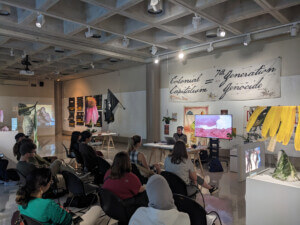Three women deans recently departed their posts: Eva Franch i Gilabert of the Architectural Association (AA), Lesley Lokko of the Bernard and Anne Spitzer School of Architecture at the City College of New York (CCNY), and Harriet Harriss of the Pratt School of Architecture. It’s risky to write about these events as linked happenings, as the circumstances are varied enough that any generalization threatens to flatten the particulars of each context. Nevertheless, not making general observations avoids the significance of these departures and the institutional lessons that might be learned.
Prior reporting in AN about Franch i Gilabert, Lokko, and Harriss, in chronological order, among other publications, established the facts of each dean’s situation. The departures are very different personally—especially along the fired/resigned axis—and institutionally: The AA is private, tuition-driven, and a school unto itself; CCNY is a public institution in a large university system and dependent on state money and state sanctioning; Pratt is a school in a codependent administrative and financial relationship with its larger art institute. Still, these departures have commonalities that need to be examined. (Full disclosure: In 2007, I left my job as head of architecture and planning at the University of Auckland after six months in the role when I realized that I was supposed to move papers from the left side of my desk to the right side of my desk instead of doing what I thought I was hired for—revitalizing a flagging school.)
First, and not surprisingly, is the fact that these departures were procedurally controversial. Franch i Gilabert’s vote of no confidence occurred via an early-pandemic Zoom meeting that caught students and AA community members off guard; procedures were seemingly made up in real time as they went along. Lokko’s resignation left the school stunned and unable to publicly digest the accusations of racism, overwork, and lack of support. Harriss’s “stepping down,” while couched in the language of personal choice, is a highly negotiated exit summary masking fears of lawsuits regarding discrimination against women. (None of the three women were contacted for this text.) Architectural academia doesn’t often witness men exiting in such quick turmoil.
The pandemic’s role in these situations should be emphasized. The need to provide a virtual education that satisfied both faculty and students with no road map was—and is—overwhelming. It was extremely tough on all academics at the time, but particularly hard on those who, like Franch i Gilabert, Lokko, and Harriss, new in their positions, lacked institutional knowledge or an established trust with school administrators. Wherever one’s sympathies lie, these three deans didn’t receive adequate support.
Another commonality is their attractiveness as hires: They were—and are—stars. Announcements about their hiring were met with cheers in the belief that, finally, agents of change had been installed (and these schools could then show off the significance of this change). Each came with a reputation for exceptional vision, but the trope of exceptionalism works awkwardly with women. It allows women to compete in a system constructed by men in which bravado is valued, but it also sets in motion the performance of bold, top-down leadership that the institutions want and the leaders adopt—a performance that, while expected, is nevertheless at odds with the horizontality of leadership assumed to come with women in charge. Imperiousness is met with resistance precisely because it was assumed to have vanished. The “star” quickly becomes “the other.”
These deans were “others” in various senses. Each came from countries outside their institution: Franch i Gilabert joined the AA from the United States, where she had directed New York’s Storefront for Art and Architecture; as a European she was not unfamiliar with Continental architectural education, but being Spanish didn’t make her Anglo-Saxon. Lokko had worked in the U.S. but built her career largely in the United Kingdom and Africa. Harriss had briefly held teaching roles in the U.S. but joined Pratt from the U.K., where she had led the postgraduate research program in architecture and interior design at the Royal College of Art in London.
All three assumed their administrative positions via reputations built on work outside of traditional academia. The Storefront for Art and Architecture is an institution explicitly aimed at filling in the gaps in conventional architectural culture. Lokko’s reputation largely stemmed from her creation of the Graduate School of Architecture at the University of Johannesburg, an activist, non-European, Africa-centric entity. Prior to joining Pratt in 2019, Harriss developed a reputation based on her critiques of the profession, her leadership in unionizing architects in the U.K., and her profile as a radical feminist. These othernesses were not unrecognized by the institutions that hired them; they sought leaders with a fresh approach to education. But when these characteristics were applied to institutions unprepared for the internal structural change invited by these leaders, they became problems.
All three also assumed positions previously occupied by men whose legacies needed to be undone, even as those legacies remained models of “success” for their schools. It is unfair to link George Ranalli, Brett Steele, and Tom Hanrahan closely because they had distinct leadership styles, but they nevertheless represent three performances of maleness. Brought in to counter these examples—Franch i Gilabert arrived with a more politically engaged agenda than Steele’s, Lokko with goals that didn’t center white male practicing architects, and Harriss with a collaborative and staff-empowering vision—these alternative visions that come from not being men and not being part of the club were ultimately not actually wanted or their implications were not fully understood. Out went feminist leadership.
The women, in other words, entered a system that was ripe for their failure. As such, their fates offer a mirror for our architectural academic institutions, one that evidences a reality architecture has been happy to ignore for too long.
First: Our academies are “corporate” in nature. The term is not a description of administrative style but, rather, an ontological fact. In a nonprofit corporation, power lies primarily with the legally required board. Board members tend to prize a version of the school’s “essence” that was formed in the past and must be preserved for the future; such inclinations are inherently conservative. Likewise, the role of the board is to monitor management, meaning that leaders are evaluated less on their “vision” than on their skills as managers whose role is to stop problems before they rise to the next administrative level. Thus, directors who think that their role is to speak for those under them, thereby raising problems, are not “good managers.” The financial precarity that almost all architecture schools—and certainly the ones interrogated here—are experiencing makes management even harder. While higher education everywhere is subject to the loss of financial support caused by market-driven governmental policies and university policies attuned to income-generating grants, architecture programs are particularly on the chopping block for their “unsustainable” low student-teacher ratios and their inefficient use of real estate. In such a context, leaders who attempt change—rather than running the same established program—risk institutional downsizing and are therefore exposed.
Second: The disarray of our discipline is also on display. We’re exposed owing to our irrelevance in the face of environmental, habitation, and land-stewardship crises; our self-consciousness about architecture’s role in unsavory urban development; and our proliferation of a mode of instruction that is biased, sexist, and self-interested. The problems at SCI-Arc and the Bartlett are examples of prestigious schools shaken by controversy in the face of cultural and political change.
This disarray also affects our professional realms. Architecture publications like this one now regularly cover how our disciplinary seams are coming unraveled. Many not-for-profits like the Architectural League and the Center for Architecture in New York City are on the side of change, and activist groups like Dark Matter University, ArchicteXX, and The Architecture Lobby are envisioning a more powerful, fair, and effective profession. If only NAAB, NCARB, and the AIA could get the message.
The combined problem of corporate risk aversion and disciplinary insecurity yields an academic context particularly incapable of the change needed to address a built environment—and a discipline—in crisis. No wonder these three women “got it wrong”—the whole thing is wrong.
There is good news, as the vacated positions have been filled with people who continue efforts of reform. Ingrid Schröder, formerly the head of design teaching and director of the MPhil in architecture and urban design at the University of Cambridge Department of Architecture, is now the director at the AA; Marta Gutman, an impassioned worker rights advocate, advanced from acting dean to dean at CCNY; and, at Pratt, Quilian Riano, a Latino educator devoted to disciplinary change, is serving as interim dean. The fact that two of these positions were filled by insiders, Gutman and Riano, and the third is well-known in London-centric academia is not surprising; in moments like this, outside hires are neither safe nor prudent.
All three women remain successful: Franch i Gilabert is working with the City of Barcelona to create Model, a new space for experimental architecture, and is working with students from the Academy of Arts, Architecture and Design in Prague to create the Future Architectures Platform. Lokko returned to Accra, Ghana, in 2021 and established the African Futures Institute, a postgraduate school of architecture and public events platform, and is curating the 2023 Venice Architecture Biennale, which will envision Africa as the laboratory of the future. Harriss is currently finishing two books—100 Women Architects and Architectural Pedagogies of the Global South—and is completing a €500,000 Erasmus grant that examines the multisector impact of an architectural degree.
There are other scholastic signs of life. Ana Miljački, associate professor at MIT, centered important change through guest editing Log 54 on the theme “Coauthoring” with Ann Lui and, with Jay Cephas and Igor Marjanović, issue 76.2 of the Journal of Architectural Education, with the theme “Pedagogies for a Broken World.” (Issue 77.1, edited by V. Mitch McEwen, Cruz Garcia, and Nathalie Frankowski, under the theme of “Reparations!,”stands to go further.) The Architecture Lobby, of which I am a member, recently produced the virtual Architecture Beyond Capitalism summer school, which operated outside systems of (expensive) institutional matriculation, academic accreditation, and professional licensure and imagined an educational experience that gathers international students, educators, and workers for social, environmental, and institutional engagement. Still more initiatives could be shared to evidence shifting tides.
The three departures addressed here mark three moments of reckoning. What matters is what happens next. We should check in two years from now to see whether architectural educators have risen to the occasion.
Peggy Deamer is Professor Emerita of Yale University’s School of Architecture and principal of Deamer, Studio. She is a founding member of the Architecture Lobby, a group advocating for the value of architectural labor. She is the editor of Architecture and Capitalism: 1845 to the Present and The Architect as Worker: Immaterial Labor, the Creative Class, and the Politics of Design and the author of Architecture and Labor. Her theory work explores the relationship between subjectivity, design, and labor.











